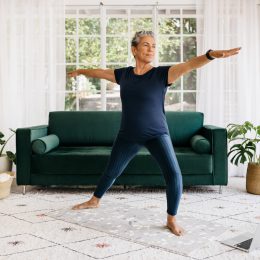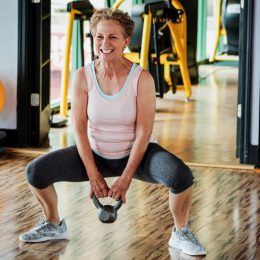The #1 Exercise All Older Adults Should Be Doing
Find out why the squat might be the key to staying independent—and the best way to do them for your body.
The squat is the single most important exercise we do in the gym. Why? Because life demands that we do it multiple times every day—to stand up, sit down, get out of a car, and more. So it’s crucial to establish a good foundation for this movement pattern.
“If our patterns are off, we become limited in our range of motion or get weaker in the muscles we need to stand up and sit down safely,” says fitness expert David Jack. “We’ll begin to compensate and use other muscles we shouldn’t in order to do everyday movements.”
Do these compensatory movements long enough, and you risk overloading other parts of your body—and losing the ability to get up and down on your own. “It happens quickly if we let it slip,” Jack says.
How do you avoid letting it slip? Follow these steps to set a strong foundation for a great squat.
As always, safety is key. The exercises here may be different or more advanced than those you’ll experience in a SilverSneakers class. If you have a chronic condition, an injury, or balance issues, talk to your doctor about how you can exercise safely.
Step #1: Set Your Feet
Stand with your feet at a comfortable width—hip distance works for some, while slightly wider is better for others—and toes pointed forward. The most important thing is that both feet point in the same direction, not one pointed slightly out. This helps protect your hips and keeps your feet in line, creating a solid base.
Step #2: Lower into a Squat
Keeping your eyes forward, chest up, and heels planted, push your hips back to lower into a squat. Make sure your knees track over your ankles and don’t cave inward—it helps to think about pushing your knees out slightly. Reach your arms straight out from your shoulders to help counterbalance. Once you squat as far as comfortable, push through your heels to return to standing.
Step #3: Check in With Your Body
Other than slight muscle fatigue, did you feel pain in any joint or area of the body? Were your knees caving inward or heels coming off the floor? What about your back? Did it hunch over as you lowered your hips or stood back up? If you answer yes to any of these questions, you’ll want to make the movement easier (more on that below).
If you don’t experience any pain and you’re able to maintain good form, stick with the basic bodyweight squat. When you can do at least two full sets of 10 reps without feeling pain or soreness in your muscles or joints the next few days, then you can make it more challenging (more on that below too).
Need to Make It Easier? Do This
If a bodyweight squat is too challenging for any reason—strength, pain, or mobility issues—you have a few options for making it easier. First, you can start your squat from a seated position, Jack says. Simply sit down, and plant your feet on the floor. From there, keep your chest up, knees out, and push down through the floor to stand up. Lower back down to the chair.
If you have a knee issue that hurts when you squat, start from a seated position and push up just a couple inches. Once you feel some tension, release to sit back down. Even with this small range of motion, you’ll still build strength in your legs, hips, and core.
Need to Make It Harder? Do This
Like any exercise, it’s important to make the squat work for you. “It should serve you, not steal from you,” Jack says. That means establishing a smooth, pain-free pattern before you even think about increasing the intensity.
Feeling confident about your squat? You can make it more challenging in a number of ways. Try one or more of these suggestions from Jack.
Subscribe to our newsletter
It's quick and easy. You could be one of the 13 million people who are eligible.
Already a member? Click to discover our 15,000+ participating locations.
Follow Us
Perform more total reps. If you’ve been doing three sets of 10 reps (30 total), you could do three sets of 15 reps (45 total) or four sets of eight reps (32 total).
Add weight. You could hold dumbbells, a medicine ball, or a kettlebell. It’s always best to start with a lighter weight, and go up gradually.
Change your tempo. Take a full three counts to lower down, pause at the bottom, and then slowly push up. “It changes the time under tension and the way the muscles have to work,” Jack says.
Make your brain multitask. “You can keep doing bodyweight squats and add something like throwing a ball off the wall or to someone,” Jack says. “It’s really fun and really important!”
Take Your Favorite SilverSneakers Classes Online!
SilverSneakers members can access live fitness classes and wellness workshops through SilverSneakers LIVE. See the latest schedule and RSVP for classes here.
Not a member? If you have a Medicare Plan, it may include SilverSneakers—at no additional cost. Check your eligibility instantly here.





